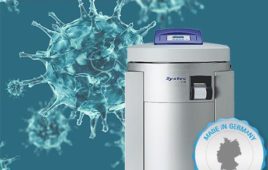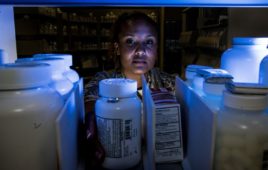Monitoring and Trending Data for Controlled Environments is Assisted by a Managing Microbes System – Part 1
A “cleanroom” by any other name…
Some medical manufacturers have taken a unique posture toward voluntary standards by describing certain manufacturing spaces as “controlled environments,” “whiterooms,” or “specified manufacturing areas” instead of “cleanrooms.” Perhaps this is done with the understanding that doing so relieves the potential requirementto comply with ISO 14644. [1, 2] The new versions of the standards and otherguidelines [3-5] list “controlled environments” as requiring certification,so the use of some other name for a cleanroom is not an escape. It is the intendedor required use of the environment that will be scrutinized by auditors, andnot the descriptive name.
More importantly however, monitoring and control of environments for manufacturing medical devices or other medical products is not necessarily a requirement. That is, it is not a requirement unless such controls are necessary to assure the “quality, dependability, reliability, safety, efficacy, performance, strength, purity or specificity” of the product. [6] There are many products that are not impacted by environmental par-ticulates or microbes. However, if a manufacturer cannot logically assert and support the contention that the environment could not have an impact on product quality attributes, then process specific, objective evidence would have to be generated to support such a contention. In this article, we will discuss the role of voluntary consensus standards in meeting non-voluntary regulatory requirements.
Regulations
FDA and ISO regulations [6, 7] cite the need for monitoring and control of the manufacturing environment. The FDA Quality System regulation addresses issues related to manufacturing environmental controls in sections 21 CFR 820.3, 820.70 and 820.75 discussing processes, process controls and validations. Sections 820.181 and 820.184 cover documentation requirements for processand device records.
Section 820.3 defines lots as components or finished devices that are manufactured under essentially the same conditions and quality. It further defines quality as the totality of the characteristics that bear on the devices fitness-for-use, including safety and performance. In addition, process validation requires objective evidence that a process consistently produces a product meeting its predetermined specifications.
820.70 states that each manufacturer “shall develop, conduct, control, and monitor production processes to ensure that a device conforms to its specifications… Where environmental conditions could reasonably be expected to have an adverse effect on product quality, the manufacturer shall establish and maintain procedures to adequately control these environmental conditions.” It also states that periodic inspections verifying the systems are functioning must be established, documented, and reviewed.
820.75 goes into further detail with the requirement that the processes discussed above must be validated when they cannot be fully verified, and that the processes be monitored so as to assure specified requirements continue to be met.
Rationale for Decisions
If a company chooses not to follow guidelines, then the supporting rationale for the decision should be documented and re-evaluated if product risk is altered. After all, one does not have to comply with any of these consensus standards, since they are all voluntary. A manufacturer can choose to comply with the standard or not, regardless of what terminology they use to define the manufacturing space. However, the non-voluntary FDA Quality System regulations dictate that if the environment could affect the product quality attributes then one must be able to justify the choice of the selected testing program and how one isassuring conformance to it.
Regulatory auditors have been delegated significant responsibility to assure safety of medical products, and directly or indirectly, the safety of the users. However, many such auditors cover a broad scope of technologies and may have limited education, experience, and understanding of particular topic like the rest of us. Therefore, these auditors will often rely on voluntary standards prepared by a consensus of knowledgeable professionals for guidance as to what factors may be important for controlling manufacturing environments. Auditors rely on voluntary standards for guidance on “good practice” in their efforts to make sound judgments regarding regulatory requirements. For manufacturers to fail to be knowledgeable about such voluntary standards would appear naïve, even if they choose not to comply.
| In many cases, environmental particulates and microbes have no impact on the medical products being manufactured. This is particularly true for products that may be cleaned, decontaminated, passivated or rinsed prior to final packaging.
|
 |
Achieving Compliance
Guidelines frequently contain language indicating the listed requirements are the “minimum.” This wording suggests that in the opinion of the authors and reviewers of these voluntary standards, the “must” or “shall” sections are considered the minimum requirements to achieve and maintain control of the specified process, environment, etc. An argument by the manufacturer that the requirements in the voluntary standards are too extensive has little likelihood of success. Legitimate and defendable efforts made to avoid compliance to voluntary standards are often more extensive and therefore more costlythan simple compliance.
With the changes in quality systems, such as those specified in ISO 13485:2003, risk assessment, including the impact of environmental controls, must be performed. The risk assessment task can be minimized by demonstrating other comparable devices are manufactured in similar classes of controlled environments or cleanrooms identified in the voluntary guidelines. The ISO standard states:
* 7.1 Planning of product realization
The organization shall establish documented requirements for risk management throughout product realization.
* 7.5.3.2.2 Particular requirements for active implantable medical devices and implantable medical devices
In defining the records required for traceability, the organization shall include records of all components, materials, and work environment conditions, if these could cause the medical device not to satisfy its specified requirements.
* 6.4. Work Environment
The organization shall determine and manage the work environment needed to achieve conformity to product requirements… b) If work environment conditions can have an adverse effect on product quality, the organization shall establish documented requirements for the work environment conditions and documented procedures or work instructions to monitor and control these work environment conditions.
Companies no longer necessarily need to hire or contract experts, as information on the basics of good practice is contained in voluntary standards.
The Benefit of Environmental Testing
In many cases, environmental particulates and microbes have no ultimate quality impact on the medical products being manufactured. This is particularly true for products that may be cleaned, decontaminated, passivated, or rinsed prior to final packaging. With many products designed for terminal sterilization, the contamination imparted by a well controlled environment turns out to be insignificant. However, without objective evidence correlating product quality to utilities and environmental data, this cannot be demonstrated.
Without historical data maintained in a baseline monitoring program, one cannot determine what levels of environmental contamination pose no problem for the product, and at what levels the risks for the product, users, and manufacturers, begin to increase. If the environment could reasonably have an impact on the product quality attributes, then a scientifically defendable monitoring program is a requirement [6]. Once baseline data has been gathered, a rational reduction of some testing may be recommended.
Unusual product bioburden contamination discoveries made during root cause analysis may be correlated directly to ordinary environmental excursions. The environmental excursions are predictable in that certain types of activities, lack of activities, or changes result in increases in bioburden levels for the environment. This approach may allow manufacturers the ability to correlate microbial levels, types, and sources when problems with product arise. Manufacturers can then determine whether the microbes causing the problem are new, or simply present in higher numbers than previously measured.
When appropriate alert and action levels have been established for “controlled environments” from the baseline data and subsequent monitoring, it is feasible to identify potential problems at alert levels before they create unacceptable product. Prospective “controlled environment” planning has saved clients both money and valuable resource time. Preventing problems before product quality issues arise is one of the primary purposes manufacturers should perform such monitoring programs. A scientifically based, pragmatic approach to controlled environmental monitoring should ensure consumer safety and reduce manufacturer cost and risk.
Conclusion
It is important not to proceed with a myopic view of voluntary standards. These standards are derived from a consensus of experts. Auditors rely on such voluntary standards, and often it is straightforward for manufacturers to understand the standards and comply. If a company chooses not to comply, then they should develop two sets of rationale. The first is why they do not, or need not comply, and the second is why the testing and controls used are appropriate for their products and processes in the absence of complianceto the voluntary standards.
References:
- International Organization for Standardization (ISO). Cleanrooms and associated controlled environments – Part 1: Classification of air cleanliness. [ISO 14644-1:1999(E)]. Switzerland. ISO: 1999.
- International Organization for Standardization (ISO). Cleanrooms and associated controlled environments – Part 2: Specifications for testing and monitoring to prove continued compliance with ISO 14644-1. [ISO 14644-2:2000(E)]. Switzerland. ISO: 2000.
- US Pharmacopeia <1116> Microbiological Evaluation of Cleanrooms and Other Controlled Environments. USP 29; The United States Parmacopeial Convention, Rockville, MD. 2006.
- Fundamentals of a Microbiological Environmental Monitoring Program, Journal of Parenteral Science & Technology, Technical report No. 13, Revised, 2001. PDA Inc., Bethesda, MD.
- PDA Comments: USP on Microbiological Evaluation of Cleanrooms and Other Controlled Environments <1116>. PDA Journal of Pharmaceutical Science & Technology, Vol.51, No. 6, 1997.
- Food and Drug Administration 21 CFR Part 820, Medical Devices; Current Good Manufacturing Practice (cGMP); Final Rule October 7, 1996.
- International Organization for Standardization (ISO). Medical devices—Quality management systems—Requirements for regulatory purposes. [ISO 13485:2003].
Switzerland. ISO: 2003.
Gregg A. Mosley is President of Biotest Laboratories, Inc.8990 Springbrook Drive NW,Minneapolis,MN.He is lead instructor for the AAMI course,“Industrial Sterilization of Medical Devices” and a qualified instructor for the AAMI/FDA course “Quality System Requirements and Industry Practices.”Gregg holds B.A.and M.S.degrees in microbiology from the University of Montana.He has close to 40 years of experience as a microbiologist,chemist,and biochemist in academic and industry positions.Gregg may be reached at 763-785-2414 or [email protected]
Biotest Laboratories is an FDA registered, ISO/IEC 17025 and 13485 certified firm providing medical device services.



